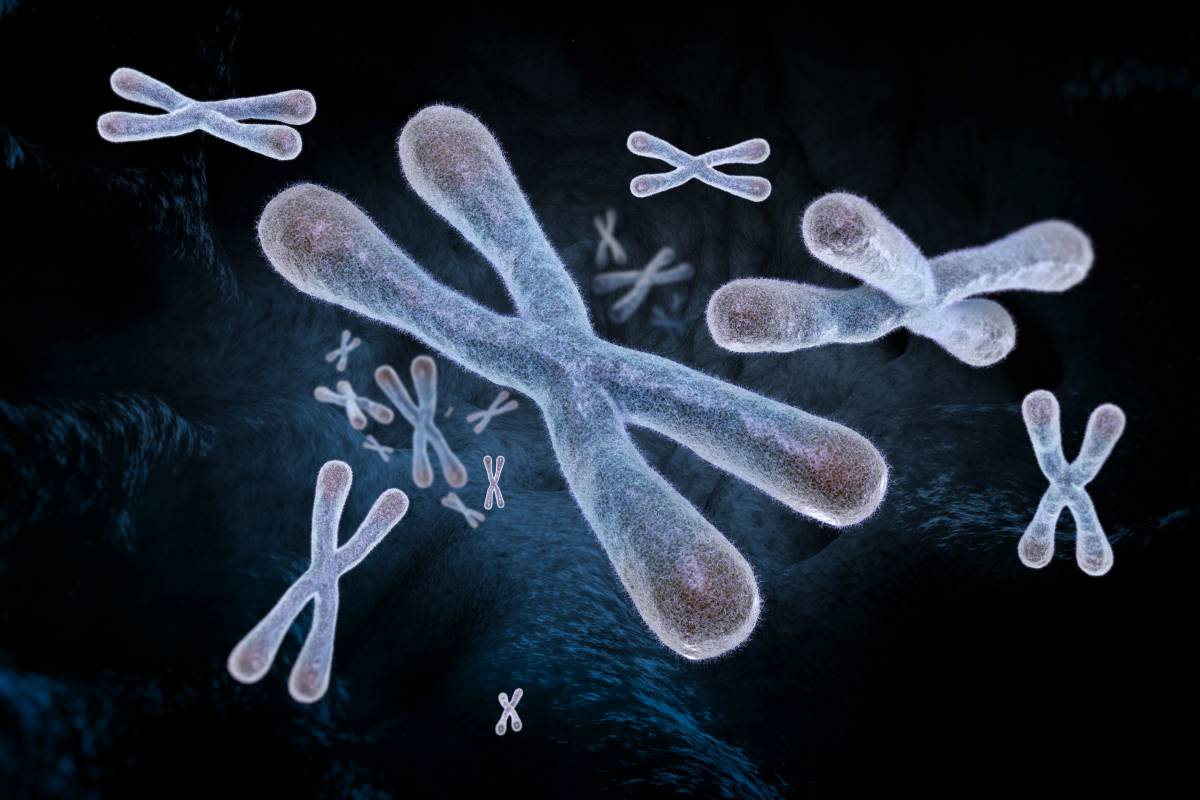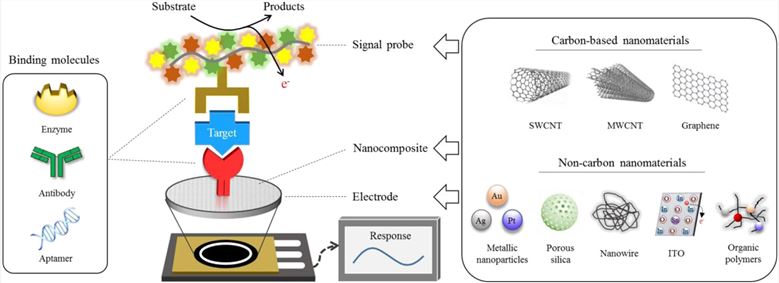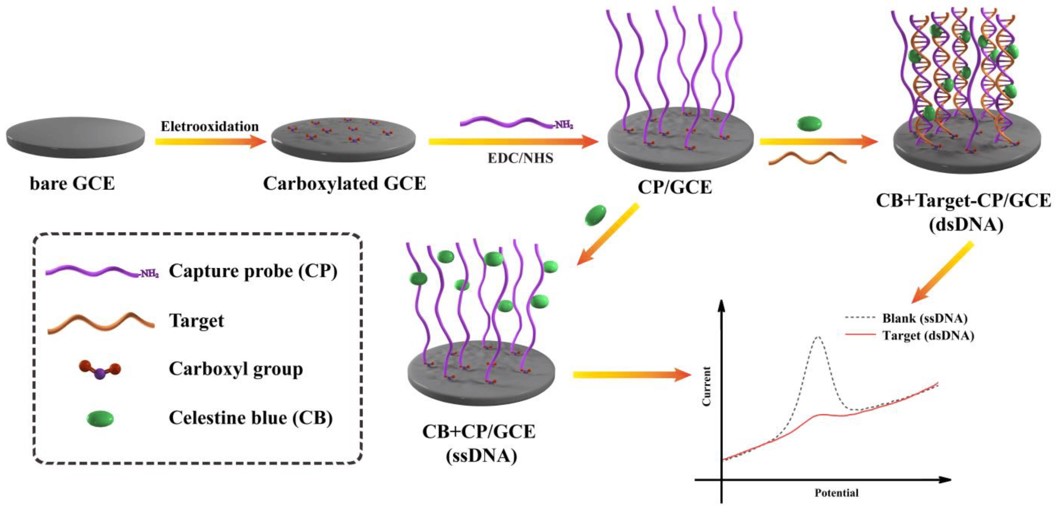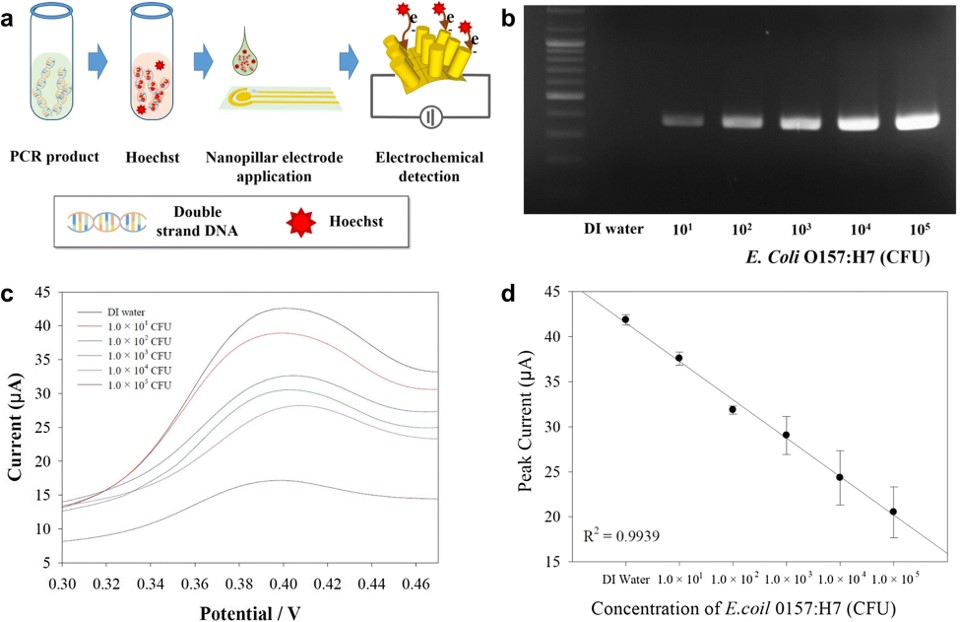Advancements in nanotechnologies have enabled the development of highly sensitive and highly specific electrochemical sensors, making them attractive for the detection of mismatched base pairs in many genetic diseases. Electrochemical sensors show great promise since they are capable of precise DNA recognition and efficient signal transduction. Creative Biolabs has an experienced team with wide variety of expertise ranging from biomolecular interactions and genetic disease detection research to coating and characterization of thin solid metal films. We provide customized electrochemical biosensors or development services for genetic diseases detection research.
Genetic-related Diseases Detection
The detection of DNA sequence plays an important role in the diagnosis of genetic-related diseases and conditions, especially for early stage treatment and monitoring. Because of the complex nature of DNA, the detection of single or small numbers of base mismatches requires high sensitivity and specificity. Many detection techniques have been developed that rely upon target hybridization with radioactive, fluorescent, chemiluminescent, or other types of labeled probes. Besides, there are some indirect detection methods that are based on enzymes, which catalyze the generation of colorimetric, chemiluminescent, or fluorescent signals.

Electrochemical biosensors have recently found extensive applications for on-site biosensing and detection. While offering simplicity in operation and sample manipulation, the contemporary electrochemical biosensors also provide highly sensitive and specific measurements for a broad spectrum of biomolecules. The sample size required for current electrochemical biosensor is small and the detection time is relatively fast. Electrochemical biosensing for DNA diagnostics is becoming a very promising area of research and development.
Electrochemical Biosensor Design Strategy
Current electrochemical biosensors for DNA diagnostics include two schemes for biologic recognition. The most common scheme is hybridization-based DNA detection which uses nucleotides as the probe and targets elements. Under this circumstance, the performance of biosensors is highly dependent on the affinity between the target and probe. This detection system can either use a one probe versus one target scheme, a multiple probe versus single target scheme, or vice versa.
Another detection scheme is enzymatic-based DNA detection. In this scheme, DNA-related enzymes are introduced into the biorecognition system and changes in amount of these enzymes correlate to specific biologic process. For instance, when an biosensor experiences a specific process, the enzyme level increases or decreases, resulting in amplification or reduction of the signal. The enzymatic process is highly specific to a DNA sequence, which makes it ideal for DNA mismatch detection.
 Fig.1 Analytical principal scheme for electrochemical biosensors.1, 2
Fig.1 Analytical principal scheme for electrochemical biosensors.1, 2
What we can do for you?
Electrochemical biosensors, coupling the inherent specificity of DNA recognition reactions with the high sensitivity of physical transducers, hold great promise for sequence-specific detection. These nanomaterial-based electro analytical bioplatforms have demonstrated enhanced sensitivity, selectivity, minimal interferences from biological matrices and prolonged stability. Our featured services include but not limited to the following:
- Different electrochemical affinity biosensing approaches such as immunosensor and DNA sensor
- Microparticle implementation
- Electrochemical determination
- Genetic mutation and DNA methylation detection
- High-quality aptamer supply
Biosensors based on DNA, RNA are the most sensitive tools, due to a strong pairing of lined up nucleotide strands between bases in their complementary parts. With further development and integration of emerging technologies, electrochemical DNA sensors will become more prominent diagnostic tools for detecting a broad spectrum of genetic-related diseases and conditions. If you are interested in our services, please feel free to contact us for more information.
Published Data
1. Electrochemical DNA Biosensor for Osteosarcoma Survivin Gene Detection
 Fig.2 Diagram of a label-free electrochemical DNA sensor for the detection of the survivin gene.3,2
Fig.2 Diagram of a label-free electrochemical DNA sensor for the detection of the survivin gene.3,2
This study presented a sensitive electrochemical DNA biosensor for detecting the osteosarcoma-associated survivin gene, utilizing celestine blue (CB) as a label-free indicator for hybridization. This approach utilized a simple, low-cost working electrode, eliminating the need for additional substances for electrode or DNA functionalization. The interaction between CB and DNA was studied using electrochemical and spectroscopic techniques, demonstrating an intercalation binding mode. The binding number was determined to be 2, and the binding constant (β) was calculated as 1012.87. The biosensor showed a linear response to the target gene in the range of 1.00 nM to 50.00 nM, with a detection limit of 0.046 nM (3σ). This efficient, label-free electrochemical approach allows fast and precise detection of the target sequence in complex serum samples, showing promise for diagnosing and monitoring genetic diseases.
2. Genetic Detection of Foodborne Pathogens Using Flexible Nanopillar-Based Electrochemical Sensors
 Fig.3 Illustration of NPE-based electrochemical evaluation of foodborne pathogens E. coli O157:H7.4,2
Fig.3 Illustration of NPE-based electrochemical evaluation of foodborne pathogens E. coli O157:H7.4,2
This study developed a flexible electrochemical sensor based on a polyaniline nanopillar array for genetic analysis of foodborne pathogens. The nanopillar electrodes were fabricated using soft/photo-lithography and metal evaporation, resulting in highly ordered arrays with superior electrochemical and mechanical properties. The large space between the nanopillars facilitated efficient electrolyte interaction, enhancing sensitivity. Gold and silver electrodes on the nanopillars demonstrated stable electrochemical performance for detecting amplified genes from Escherichia coli O157:H7. The lightweight, flexible, USB-connectable sensor platform improved portability, connectivity, and sensitivity. Using real food samples, the sensor showed high reproducibility (6% standard deviation) and sensitivity (10 × 1.01 CFU) within 25 seconds via square wave voltammetry. This study highlighted the great and considerable electrochemical activity of the nanopillar electrodes making them a promising genetic biosensor for point-of-care testing (POCT).
References
- Cho, Il-Hoon, Dong Hyung Kim, and Sangsoo Park. "Electrochemical biosensors: Perspective on functional nanomaterials for on-site analysis." Biomaterials research 24.1 (2020): 6.
- Distributed under Open Access license CC BY 4.0, without modification.
- Chen, Yao, et al. "Facile label-free electrochemical dna biosensor for detection of osteosarcoma-related survivin gene." Biosensors 12.9 (2022): 747.
- Park, Yoo Min, et al. "Flexible nanopillar-based electrochemical sensors for genetic detection of foodborne pathogens." Nano convergence 5 (2018): 1-8.
For Research Use Only.

